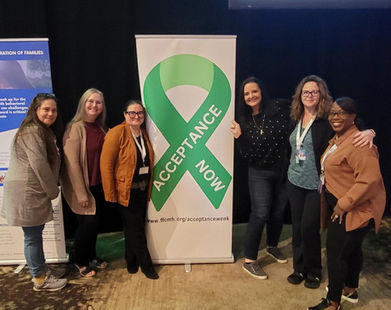In 2022, the National Federation of Families took an important step: launching the first national Children’s Mental Health Acceptance Week. This uplifting campaign allows all of us to celebrate children of any age while promoting the importance of their mental health as well as their need for services and acceptance that support wellness, resilience, and success for children and their families.
Making the Difference
The National Federation reaches out to you, in our shared vision for our nation’s children, youth and families. It is through our combined efforts that growth, renewal, and the promotion of positive mental health will impact the well-being of our children.
The History of CMHAW
Watch our video below showcasing the history of Children's Mental Health Awareness to Acceptance Week.
Why Green?
In the 1800s, the color green was used to brand people who were labeled “insane.” The children’s mental health community decided to continue using the color green, but with a completely different focus. Green signifies new life, new growth, and new beginnings. Today, green signifies the need to collectively better the lives of children with mental health challenges, as well as supporting these children and their families across the lifespan. The green ribbon is now the international symbol to demonstrate support for mental health.
The History of Children’s Mental Health Acceptance Week
1949 The National Mental Health Association declared May as Mental Health Awareness Month. Although this nationally recognized observance began as Mental Health Week, with an increase in public interest and a broadening scope of issues, it grew into a month-long awareness campaign.
1950s-60′s Through the next 2 decades, special emphasis was placed on educating the public around mental illness and inviting them to state hospitals and other locations to learn more. In the late 1960s, this national observance was expanded, and May was declared Mental Health Month.
1970s In the 1970s, observances shifted to community-based events as state hospital “patients” were moved to community settings.
1992 A group of parents in Missouri got together and decided that one of the most important projects they could undertake was to raise awareness surrounding children’s mental health. They formed a coalition of parents, professionals and other stakeholders and created Children’s Mental Health Awareness Week. Over the next five years three more states, Kansas, Illinois, and Ohio began their own celebration of Children’s Mental Health Week. The National Federation of Families later joined the coalition and promoted the mission.
1996 PAL, today called PPAL, launched the first Children’s Mental Health Week in Massachusetts. Its theme was “One Youth at A Time” and included posters, a tool kit, as well as public service announcements. The campaign has grown each year since then.
2004 The National Federation of Families declared the first full week of May as Children’s Mental Health Awareness Week nationally. National Federation affiliates and partners were invited and encouraged to participate in the weeklong celebration.
2006 The Substance Abuse and Mental Health Services Administration’s (SAMHSA) Center for Mental Health Services launched an annual national initiative called “National Children’s Mental Health Awareness Day,” which occurred during Children’s Mental Health Awareness Week until 2020.
2007 The National Federation of Families launched the Annual Green Ribbon Campaign, one of its most important awareness and education campaigns. The green ribbon is a key symbol in social marketing and awareness efforts. It is an uplifting campaign that aims to spread awareness through positive public health promotion and by initiating dialogue in local, national, and international communities.
2022 The National Federation of Families updated the annual campaign name, changing the “a” from awareness to acceptance. This significant shift to "acceptance" speaks more directly to the goals of the campaign. Acceptance leverages the lessons of what our nation faced during the pandemic: we know there will be long-lasting adverse effects on mental health and wellbeing.
Today, this nationally recognized event continues to increase public acceptance, educate communities, and expand the general public’s understanding of children’s mental health needs and its resulting impact on their parents, caregivers, and families across the lifespan.



